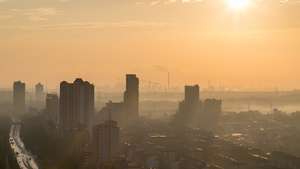
Air pollution: smog and fog in the large cities of Ukraine.
 Rostyslav Sipakov 1*
Rostyslav Sipakov 1*
1Kyiv National University of Construction and Architecture, Povitroflotskyi Avenue, 31, Kyiv, 03680, Ukraine
Received: 08/01/2018, Accepted: 08/20/2018, Available online: 09/30/2018.
DOI: https://doi.org/10.32557/useful-1-1-2017-0001
HDL: http://hdl.handle.net/20.500.12334/24
*Corresponding author: e-mail: r.sipakov@icloud.com
Under a creative commons license. Volume 1, Issue 1, 2017, pages: 01-12.
Author Keywords: smog, dust, aerosol toxicant, aerosol-gas pollution, inversion, cyclone, anticyclone, air pollution model.
Abstract
The main factors of air pollution in large cities in Ukraine are described in the article and the main factors of smog have been analyzed on the example of Kyiv in the period January - February 2017. For the analysis of sample contamination points in Kyiv, we used a mathematical model of the spread of solid and gaseous pollutants with the main factors of influence on the scattering process of contaminants in the air: heat, turbulence, chemical kinetics, etc. As a result of the simulation it was confirmed that the smog in Kyiv and surroundings was formed as a result of anticyclone and air pollution by harmful substances, soot and etc.
Indexed Keywords
Smog; Dust; Aerosol toxicant; Aerosol-gas pollution; Inversion; Cyclone; Anticyclone; Air pollution model
Introduction
The ecological condition of the air environment in big cities with complicated automobile traffic, and around the enterprises that emit many toxic substances always required special attention. To predict the spread of pollution in the air basin of the big city and in residential areas is an urgent task to provide comfortable living conditions for people in urban areas.
The atmosphere of the city is characterized by a number of adverse factors, whose effects on the human body can harm the functionality of organs and systems, and to develop the pathological conditions. Gas-aerosol toxicants make a significant contribution to the structure of environmental pollution in the industrial cities such as Kyiv, Odessa and others. They are capable to circulate in the system "atmosphere - soil - atmosphere" for a long time, accumulate in organs and tissues of living organisms entering through the respiratory system and digestive system, thereby increasing their toxicity.
Urban air pollution is mainly is a result of combustion processes. Fuel is usually composed of hydrocarbons, except exotic impurities mainly, such as missile industry emissions, where sometimes nitrogen, aluminum and even beryllium are used. Fuel Burning seems harmless at first, but it can lead to the formation of a number of polluting carbon compounds.
Presentation of the main material of the study
The most unfavorable conditions for air pollution are created in the winter and spring. The city has a large number of sources of aerosol emissions, mostly - a boiler and power plants, coal-fired vehicles, railway locomotives and other. In addition, under certain conditions (temperature, humidity, intensity of solar radiation, etc.) aerosols can be created from the gas phase of certain toxicants. For Kyiv they are carbon oxide (25%), dioxin sulfur (up to 20%), dioxin oxide (10%), phenol (up 3%), carbon sulfide (up 3%), formaldehyde (1%), hydrogen sulfide (1%). According to the data of Central Geophysical Laboratory Ukrainian Weather Center, the level of formaldehyde, carbon dioxide and nitrogen in Kyiv on 17 January 2017 exceeded permissible concentrations greatly (fig. 1).
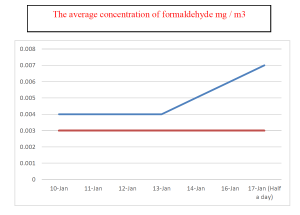
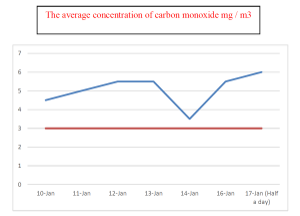
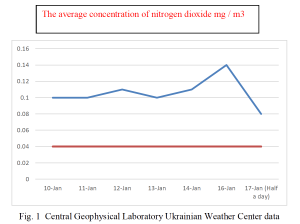
Meteorological conditions significantly affect the concentration of atmospheric pollutants at a constant power of their emissions. The concentration in the surface layer of the atmosphere depends on the temperature stratification of the atmosphere, wind speed, rainfall intensity, atmospheric pressure, humidity. Generally, periods with low levels of air pollution occur when cyclonic weather.
They are characterized by rain, significant rainfall, strong winds, no inversion. Such situations contribute to the rapid purification of air, impurities intensive dispersion.
Depending on macrosynoptical processes that make weather conditions, increasing the concentration of contaminants in the surface layer of the atmosphere occurs on the background anticyclone weather for which the inherent steady, monotonous, mostly cloudy with a surface inversions and weak winds. The increase in temperature occurs with increasing altitude at a temperature inversion layer of air that is directly above emission sources. This leads to the fact that the movement of the layers of air decreases thereby delay the transfer of atmospheric impurities. As a result of gas-aerosol pollution concentrated near the earth's surface, their concentration increases sharply.
Exhaust and industrial emissions cannot dissipate because of the inversion in the atmosphere, leading to the smog, which we have seen in some areas of Ukraine, Belarus, Poland, in January-February 2017.
January 16-19, 2017, fog and smog enveloped part of Ukraine because of anticyclone “ Brigitta”. Since optimal conditions are formed at anticyclone: no frontal winds, sudden temperature change, there is a gentle breeze or calm. As seen in weather forecast maps from January 17-18, 2017 (fig. 2), the anticyclone "Brigitta" covered almost the entire Ukraine.
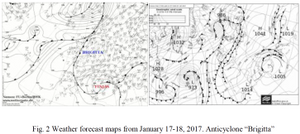
After the inversion (phenomenon where near-layers of air with a temperature much lower than the upper) vertical air circulation is difficult. This leads to the fact that vehicle exhaust and industrial emissions accumulated objects in near-Earth layers and cannot dissipate.
The most universal method for obtaining quantitative and qualitative picture of the distribution of pollution is numerous. However, using complex models and calculations on grids with many cells the number arithmetic operations are usually so large that only handle this load multiprocessor systems.
Let's apply the model in partial derivatives, with high accuracy and versatility that can get both qualitative and quantitative results accurate enough. For more accurate simulation of the propagation of the aerosol-gas toxins in three-dimensional field it is necessary to account many factors: molecular and turbulent diffusion, convection (including heat), low compressibility environment, chemical kinetics, and complex field form. Existing models [2, 7-9] or take account of these factors, or take into account all different but significant heterogeneity, reflected in the presence of three or more different types of equations, which are different methods of integration that hampers effective parallelization.
Let's consider a uniform model that takes into account all the factors listed above and only consists of two subsystems: a dynamic and kinetic (chemical reaction). The equation of each subsystem has a single form. In the kinetic subsystem includes traditional first-order differential equations. The dynamic subsystem includes the Navier-Stokes equations for the three components of velocity gas distribution equation heat equation weak compressibility of the gas diffusion equation (including greetings speed) gaseous substances equations for the three components of velocity dust, dust continuity equation (turbulence model Abramovich-Sekundovy).
The gravity and flow resistance and diffusion of dust are taken into account. All dynamical equations are brought to the form:

where G — one of the main variables of the model, (containing: - projection of the velocity on the axis ; P - pressure; T - temperature; nturb - viscosity turbulent; Сj – concentration of j substance; - the projection of the velocity vector of dust axle xi; rp – dust density); x1, x2, x3, t - Euler variables; RG and aG - coefficients; KG - function form of which depends on the equation:

where F1 = 0, F2 = 0, ; r - air density, b — thermal coefficient of air expansion, - «'excess' temperature, g=9,81 m/s 2;

where a– speed of propagation of small perturbations;

Where nmol - molecular viscosity;g = 50,0;b = 0,06; Lmin – the shortest distance to the wall;


where CD – drag coefficient for a given flow rates and particles; rsubs – density of substance particles; ap - radius of particle. The drag coefficient is determined from the following formula:

where Rep - local Reynolds number for spherical particles of dust.
The choice of turbulence model is implemented by the results of numerical experiments with different models (Prandtl, Karman, Rivard, Abramovich-Sekundovsky) for the task in the turbulent mixing of flooded flat swirling stream.
In winter, air pollution in cities occurs mainly as a result of combustion processes. Fuel is usually composed of hydrocarbons, except mainly exotic impurities, such as nitrogen, aluminum and even beryllium. Burning fuel at first seems harmless, but it can lead to the formation of a number of polluting carbon compounds.
The fuel typically consists of hydrocarbons and its conventional combustion process is according to equation:
4CH + 5O2=4CO2 + 2H2O [10]
This process is safe, since CO2 and water are not toxic substances. However, when there is insufficient oxygen during combustion, that can occur inside an engine or boiler then it can produce toxic components. The equation can be written as:
4CH + 3O2 = 4CO + 2H2O [11]
Carbon monoxide (CO), a poisonous gas is produced under such conditions. If oxygen is less, you can get carbon (i.e. soot):
4CH + O2= 4C + 2H2O [12]
At low temperatures and relatively few cases O2 pyrolysis reaction, that reaction when failure occurs by heating, can cause changes in the arrangement of atoms, leading to the formation of polycyclic aromatic hydrocarbons during combustion. The most notorious - benzopyrene, a compound that causes cancer.
Thus, despite the fact that the combustion initially seems harmless, it can lead to the formation of a number of polluting carbon compounds.
In addition, air pollution can cause impurities, comprising the fuel. Sulfur (S) is the most common impurity in fossil fuels, presented as part of the mineral pyrite - FeS2. Some coals can contain sulfur up to 6%, which converts to SО2 by combustion:
4FeS2 +11О2= 8SО2 + 2Fe2O3. [13]
Fuel contains other impurities, but sulfur has always been considered as the most common industrial pollutant. Soot, СO2 and SO2 are the primary polluters. Sulfur dioxide is readily soluble and therefore can be dissolved in the air that condenses around particles, such as smoke.
Traces of metals - iron contaminants (Fe) or manganese (Mn) catalyze the transition of dissolved SO2 into H2SO4. Sulfuric acid has a greater affinity for water, so formed drop of this acid additionally adsorbs the water. Drops are constantly growing and "fog-killer", humid smog thickens, reaching very low values of pH.
The transition from coal to hydrocarbon fuel will reduce the danger of air pollution particles of soot. However, new types of pollution, both primary and secondary appeared, resulting reactions of primary pollutants from fuel not burned and oxygen.
For equations of chemical kinetics are applicable:
- gere method for hard subsystems kinetic equations;
- explicit-implicit Rozhkov scheme, with a sufficient level of accuracy and stability at a lower computational complexity.
With these models let's construct a model of contamination intersection of two streets (Zhylianska street and Tolstoy street) in Kyiv. At the lower limit, the temperature distribution and concentration are set (dust and primary pollutants), the highest values in the vicinity of the intersection, including brake lines, lower - on the road outside intersection. For modeling we used a set of 21 reactions, typical of photochemical smog: basic reaction of ozone and peroxy acetyl nitrate; reactions involving nitrogen oxides, formaldehyde and hydrocarbons CnH2n + 2, which closes the circuit cyclic ozone accumulation mechanisms; other reactions, including the formation of nitric acid vapor. Under dust particles of sand we mean radius of 0.5 mm.
As we can see from the Figure 3 in the vicinity of the intersection, the upward flow is formed caused by thermal convection, and several zones of rotary flow. The temperature inversion formed at the top, which prevents the dispersion of contaminants (Fig. 4, the temperature is indicated in Celsius).
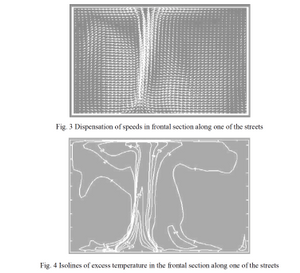
Updrafts of lower intensity are arising out on the roads outside the crossroads. In street canyons, where the traffic is small and there is no heat, flows formed in the lower part directed towards the crossroads. Herewith flow of pollutants in these canyons are at the top of the field.
Crossroads were the most contaminated sites (The highest concentrations of primary pollutants Fig. 5) and the adjacent area (moderate concentrations of primary and secondary highest concentration of pollutants in Fig. 6).
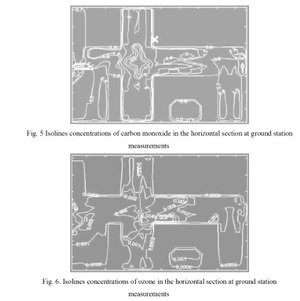
There also have been simulated contamination zone around the industrial area near the TPP-4 in Kyiv. The model - the spread of sulfur dioxide SO2 and fine dust emitted from the chimney of the enterprise. The upper limits set horizontal airflow directed towards the city, its speed is selected on the basis that at the height of the outlet pipe wind speed is 2 - 4 m/s. The area is completely open. We neglect the chemical kinetics factor, because the humidity is considered to be low, thus, the development of damp smog is impossible. The concentrations of sulfur dioxide and dust density output tubes are designed proximally, on the basis of annual emissions. There is also no precise data on the parameters of dust.
Horizontal flow formed on top of the area that pushes emissions to a considerable distance (Fig. 7). Herewith the turbulent viscosity at the top with a significant size, and dust particles are small (radius 10-4m), that's why the resistance of particle flow is large and sinking of dust flow to the surface actually did not happen. The situation is different with sulfur dioxide, which by diffusion and sedimentation rate constant pollution of the atmosphere at the surface is higher (Fig. 8).
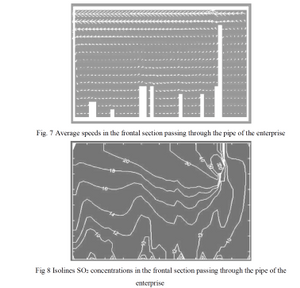
Conclusions, implications, and future directions
Thus, the analysis shows that transport (main polluter in Kyiv), the power enterprises, have a significant negative impact on the environmental components and therefore health. And the maximum human pressure falls on the air of urban areas. Reducing the concentration of pollutants contained in the flue gases can be achieved through implementing a set of measures in which along with organizational and technological, occupy an important place special engineering and environmental measures - dust gas trapping, dust and gas cleaning, and gas and dust dispersion.
As a result of anthropogenic air pollution in certain weather conditions, such anticyclone "Brigitta" there is a thick yellow fog that often causes toxic effects on living organisms and vegetation.
References
[1] Pekunov V.V., Yasinsky F.N. “Parallel solution of the problem of numerical modeling of the distribution of pollution in the air basin of a large city in the vicinity of the enterprise”. - Preprint IPM № 36, Moscow, 2003 – P. 14.
[2] Marchuk G.I. “Mathematical modeling in the problem of the environment”. — М.: The Science, 1982. — P. 319.
[3] Abramovich G.N., Krasheninnikov S.Y., Secundov A.N., Smirnova I.P. “Turbulent mixing of gas jets”. — М.: The Science, 1974.— P. 272 .
[4] “Brief Description of MAQSIP Science”. Draft Version 2.1. — MCNC North Carolina Supercomputing Center. — http://www.emc.mcnc.org /products/maqsip/users/science.html.
[5] Bruse, M. (2002), “ENVI-met implementation of the gas particle dispersion and deposition model PDDM”. — http://www.geographie.ruhr-uni-bochum.de /agklima/envimet/documents/sources.PDF.
[6] “Evaluation of MOBILE vehicle emission model”. — FHWA-PD-94-38, Federal highway administration environmental analysis division/office of environment and planning, December, 1994. — 204 p.
[7] “Guideline on Air Quality Models (Revised) and Supplements”. — EPA-450/2-78-027R et seq., published as Appendix W to 40 CFR Part 51 (7-1-99 Edition). U. S. Environmental Protection Agency, Research Triangle Park, North Carolina, 1999.
[8] Piva,R., Orlandi,P. “Numerical Solutions for Atmospheric Boundary Layer Flows over Street Canyons”. Proceedings of the Fourth Int. Conference «Numerical Methods in Fluids Dynamics», ed. R. D. Richtmeyer, Springer-Verlag, New York, pp. 319-325 (1975). https://doi.org/10.1007/BFb0019768
[9] “Transport statistics bulletin: Road traffic statistics: 2000” - Statistics report SB (01) 19. — UK Department for transport, local government and the regions, 2001. — 41 p.
[10] User's Guide for CAL3QHC Version 2: “A Modeling Methodology for Predicting Pollutant Concentrations Near Roadway Intersections”. — EPA-454/R-92-006, U. S. Environmental Protection Agency, Research Triangle Park, North Caroline, 1992.
Please cite as: R.Sipakov “Air pollution: smog and fog in the large cities of Ukraine.” USEFUL online journal, vol. 1, no. 1, pp. 01–12, September 2017. DOI: https://doi.org/10.32557/useful-1-1-2017-0001

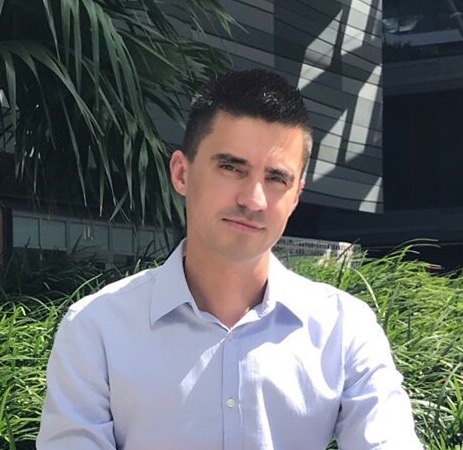

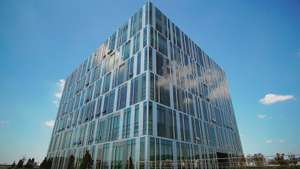




Comments